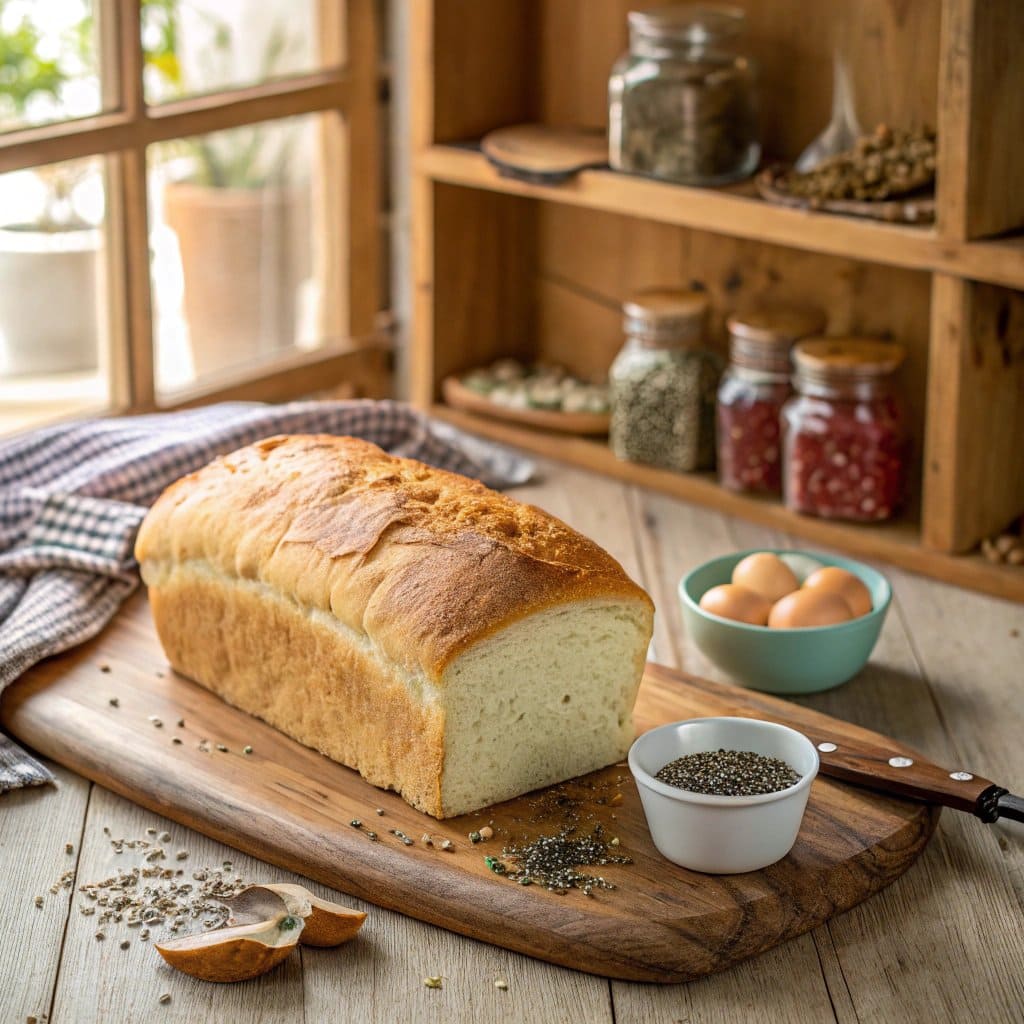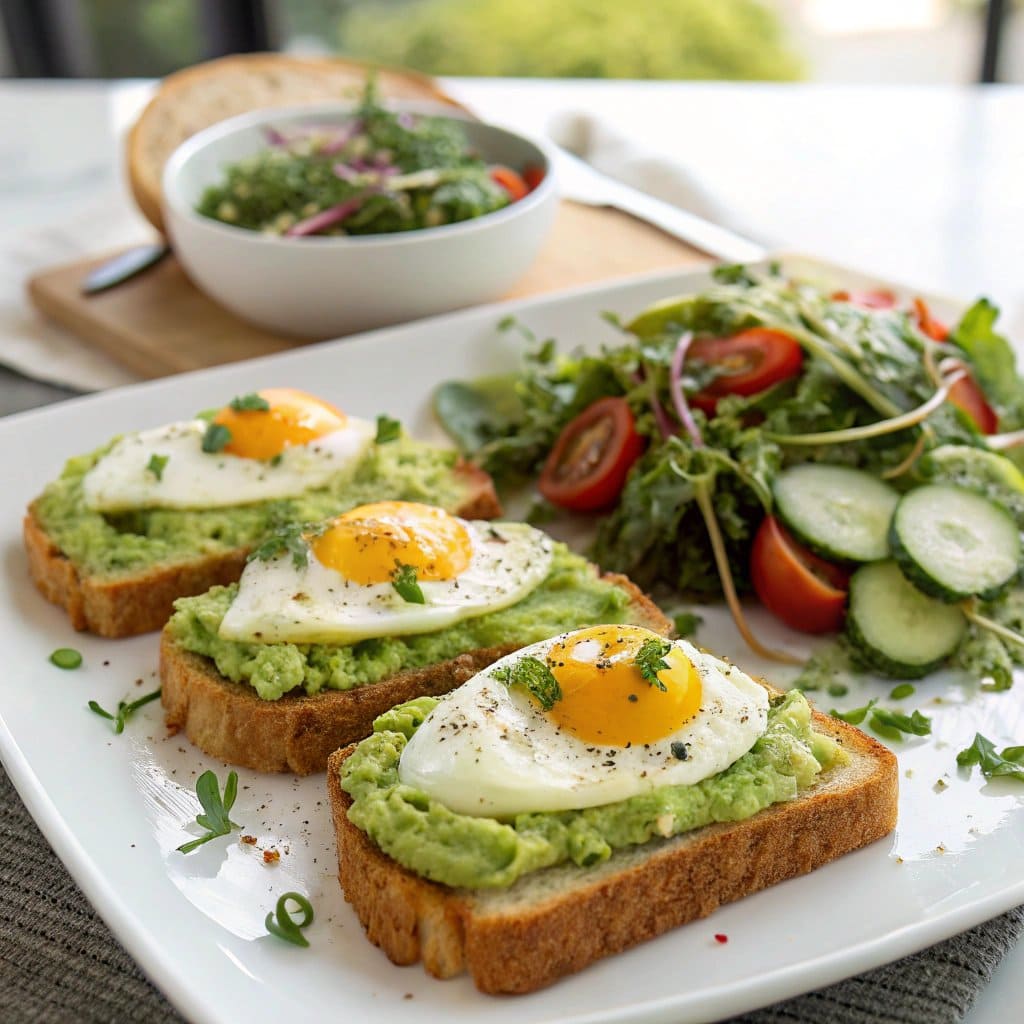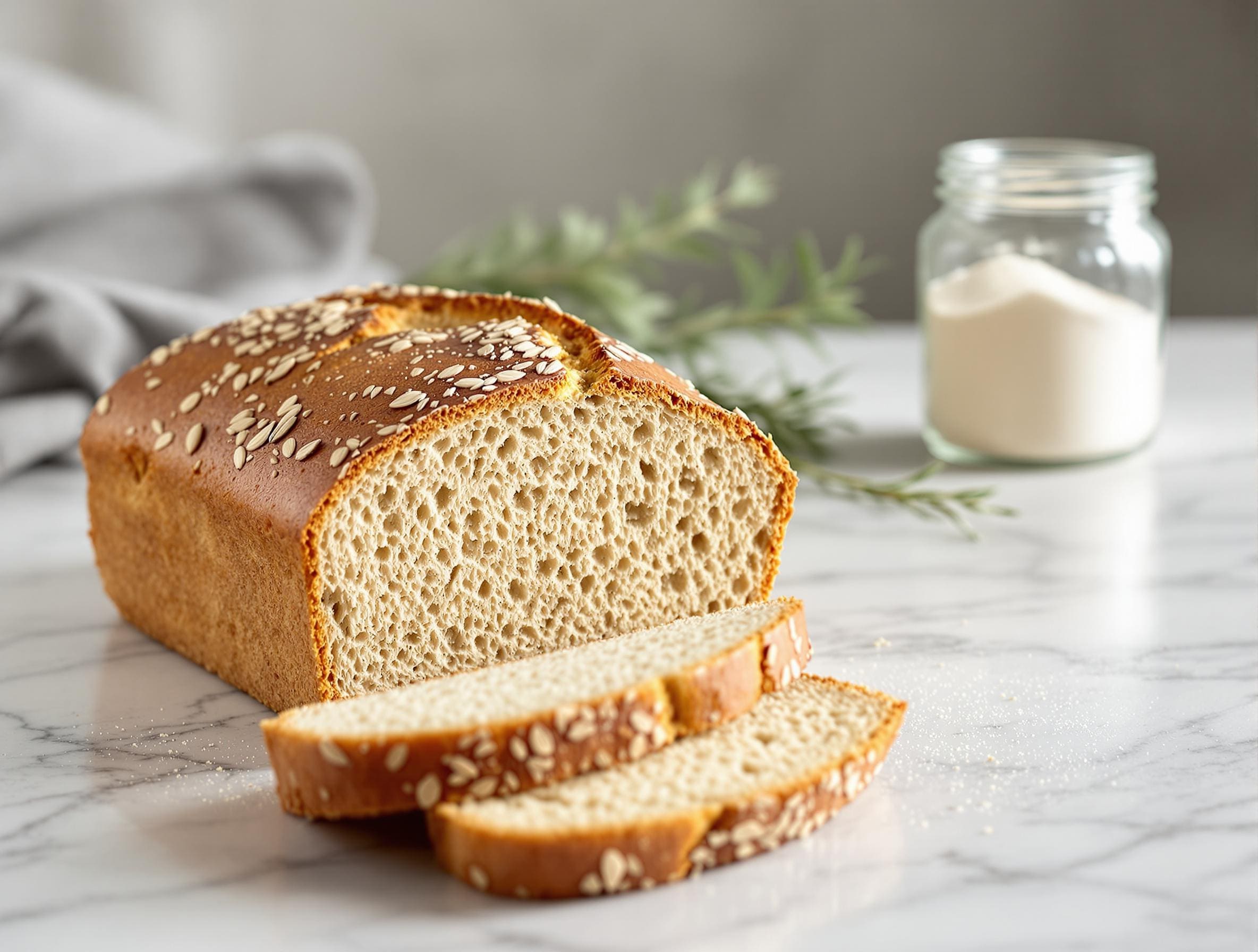Low-carb bread has become a game-changer for people looking to lead a healthier lifestyle. Unlike regular bread, which is often packed with refined carbohydrates, low-carb bread provides a guilt-free way to enjoy sandwiches, toast, and more without spiking blood sugar levels. This alternative is especially popular among those following low-carb diets like keto or paleo.
But why all the buzz? The main reason is its ability to fit into health-focused lifestyles without compromising on taste or versatility. It allows you to enjoy the comfort of bread while sticking to your health goals.
In this guide, we’ll explore why low-carb bread is worth trying, how it’s made, and how you can use it in your daily meals. Whether you’re baking your own loaf at home or buying from the store, we’ve got all the tips you need!
Table of Contents
Why Choose Low Carb Bread?
Low-carb bread is more than just a trendy food option—it’s a healthier choice for many people. Whether you’re managing your weight, balancing your blood sugar, or following a specific diet plan, low-carb bread can fit seamlessly into your lifestyle. Let’s dive into why it’s such a great choice.
Understanding Carbohydrates and Their Impact
Carbohydrates are the body’s main source of energy, but not all carbs are created equal. Refined carbs, like those in regular bread, can cause blood sugar spikes and leave you feeling hungry soon after eating. Low-carb bread offers a better alternative by reducing these effects while keeping you full longer.
How Low Carb Bread is Different
Low-carb bread is made with fewer starchy ingredients and more fiber-rich components like almond or coconut flour. These swaps reduce the carb content without sacrificing texture or flavor. The result is a loaf that supports a healthy lifestyle while still satisfying your cravings.
Benefits of Choosing Low Carb Bread
- Supports Weight Management: With fewer carbs and more fiber, low-carb bread helps curb hunger and control calorie intake.
- Stable Energy Levels: Unlike regular bread, which can lead to energy crashes, low-carb bread provides a steady release of energy.
- Improved Digestion: High-fiber ingredients like psyllium husk promote a healthy gut.
- Diabetic-Friendly: For those managing diabetes, low-carb bread is a great option to keep blood sugar levels in check.
Who Can Benefit from Low Carb Bread?
Anyone can enjoy low-carb bread, but it’s especially beneficial for:
- Individuals following keto or low-carb diets.
- Those looking to lose weight or maintain a healthy weight.
- People managing diabetes or prediabetes.
- Anyone seeking a healthier alternative to traditional bread.
By understanding the advantages of low-carb bread, you can make more informed decisions about your meals and snacks. Up next, we’ll explore the unique ingredients that make this bread so special!
Key Ingredients in Low Carb Bread
The magic of low-carb bread lies in its unique ingredients. Unlike traditional bread made with wheat flour and sugar, low-carb versions use substitutes that reduce carbs while maintaining flavor, texture, and nutrition. Let’s look at some of the key ingredients that make low-carb bread possible.
1. Almond Flour: A Nutty Favorite
Almond flour is one of the most popular ingredients in low-carb bread. Made from finely ground almonds, it’s naturally low in carbs and rich in healthy fats, protein, and vitamin E. Almond flour adds a slightly nutty flavor and moist texture to baked goods.
- Why it’s great: It’s gluten-free, low in carbs, and packed with nutrients.
- Tip: Look for finely ground almond flour for a smoother texture in your bread.
2. Coconut Flour: Light and Flavorful
Coconut flour is another excellent low-carb alternative. It’s made from dried, ground coconut meat and is high in fiber while being naturally low in carbs.
- Why it’s great: Coconut flour absorbs a lot of liquid, which helps create a firm yet tender bread. It also adds a subtle sweetness to your recipes.
- Tip: Since it absorbs so much moisture, use it sparingly and balance it with other ingredients.
3. Psyllium Husk: The Fiber Booster
Psyllium husk is a plant-based fiber that plays a key role in many low-carb bread recipes. It helps bind ingredients together and gives the bread a chewy, bread-like texture.
- Why it’s great: It’s incredibly high in fiber, promoting digestive health and helping to create a sturdy loaf that holds its shape.
- Tip: Use psyllium powder for even mixing and avoid clumps in your batter.
4. Flaxseed Meal: A Nutrient Powerhouse
Flaxseed meal is ground flaxseeds, which are rich in omega-3 fatty acids, fiber, and protein. It adds a nutty flavor and boosts the nutritional profile of low-carb bread.
- Why it’s great: It’s a great egg substitute in vegan recipes and supports heart health.
- Tip: Store flaxseed meal in the fridge to keep it fresh longer.
5. Chia Seeds: Tiny Yet Mighty
Chia seeds may be small, but they’re packed with fiber, protein, and omega-3s. They add a subtle crunch to low-carb bread while helping to retain moisture.
- Why it’s great: Chia seeds thicken the batter and make the bread more filling.
- Tip: Soak the seeds in water beforehand to create a gel-like consistency.
6. Eggs: The Binding Agent
Eggs are commonly used in those recipes to hold the ingredients together and add fluffiness. They also increase the protein content of the bread.
- Why it’s great: Eggs help create a light texture, preventing the bread from being too dense.
- Tip: Use room-temperature eggs for smoother mixing.
7. Baking Powder or Baking Soda: The Rising Star
it relies on leavening agents like baking powder or soda to rise. These ingredients create air pockets in the batter, resulting in a softer loaf.
- Why it’s great: They ensure your bread is fluffy and not too dense.
- Tip: Measure carefully to avoid an unpleasant aftertaste.
By combining these ingredients, you can create a nutritious, low-carb bread that tastes amazing. Next, we’ll guide you through making your own loaf at home!
How to Make Low Carb Bread at Home

1. Gather Your Ingredients
Here’s a basic list of what you’ll need to get started:
- 2 cups of almond flour
- 2 tablespoons of coconut flour
- 2 tablespoons of psyllium husk powder
- 1 teaspoon of baking powder
- ½ teaspoon of salt
- 4 large eggs
- ¼ cup of melted butter or coconut oil
- 1 cup of warm water
Feel free to customize this recipe by adding herbs, seeds, or spices to enhance flavor.
2. Tools and Equipment
To make the process smooth, ensure you have the following tools:
- A mixing bowl
- A whisk or electric mixer
- A loaf pan
- Parchment paper
- A cooling rack
3. Step-by-Step Instructions
Preheat Your Oven
Set your oven to 350°F (175°C) and line your loaf pan with parchment paper. This prevents sticking and makes cleanup easier.
Mix the Dry Ingredients
In a large mixing bowl, combine almond flour, coconut flour, psyllium husk, baking powder, and salt. Mix thoroughly to ensure the leavening agent is evenly distributed.
Prepare the Wet Ingredients
In a separate bowl, whisk together the eggs, melted butter (or coconut oil), and warm water. Make sure the liquids are well combined.
Combine Wet and Dry Mixtures
Gradually add the wet ingredients to the dry ingredients. Stir until a thick batter forms. The psyllium husk will absorb moisture, so let the mixture sit for a few minutes to thicken.
Shape and Bake
Pour the batter into the prepared loaf pan. Smooth the top with a spatula for an even surface. Place the pan in the oven and bake for 50–60 minutes or until the top is golden brown and a toothpick inserted into the center comes out clean.
Cool Before Slicing
Once baked, remove the loaf from the oven and let it cool in the pan for 10 minutes. Transfer it to a cooling rack and allow it to cool completely before slicing.
4. Tips for Perfect Low Carb Bread
- Avoid overmixing: Too much mixing can result in a dense loaf.
- Check for doneness: If the bread feels too soft, give it a few extra minutes in the oven.
- Store properly: Wrap the bread in plastic wrap or store it in an airtight container in the refrigerator for up to a week.
5. Variations to Try
- Cheesy Herb Bread: Add shredded cheddar and Italian herbs for extra flavor.
- Nutty Seed Bread: Mix in sunflower seeds, sesame seeds, or flaxseeds for added crunch.
- Sweet Cinnamon Bread: Add a touch of stevia, cinnamon, and vanilla for a sweet twist.
Making it, at home is a rewarding experience. Once you’ve mastered the basics, you can experiment with flavors and textures to suit your taste!
Store-Bought Options for Low Carb Bread
Popular Brands Offering Low Carb Bread
Several companies now offer low-carb bread tailored to health-conscious consumers. Here are a few well-loved brands:
- Sola Bread: Known for its soft texture and great flavor, Sola Bread contains about 2–3 grams of net carbs per slice. It’s available in various flavors like sweet oat, honey wheat, and delicious seeded options.
- ThinSlim Foods: This brand specializes in low-carb baked goods with zero net carbs per serving. Their bread has a light texture and comes in classic flavors like plain, rye, and everything.
- Nature’s Own Life 40: A popular grocery store option, this bread offers a balance of low carbs and traditional bread taste. It’s perfect for sandwiches and toasts.
- ALDI’s L’oven Fresh Keto Bread: A budget-friendly option that has gained popularity for its zero net carbs and excellent taste.
What to Look for in Store-Bought Low Carb Bread
When choosing it , it’s important to read the label carefully. Here’s what you should focus on:
- Net Carb Content: Look for breads with fewer than 5 grams of net carbs per slice. Net carbs are calculated by subtracting fiber and sugar alcohols from total carbs.
- High Fiber Content: Fiber is crucial for digestion and satiety, so choose bread with at least 5 grams of fiber per slice.
- Natural Ingredients: Opt for products made with clean, wholesome ingredients like almond flour, coconut flour, or psyllium husk. Avoid breads with added sugars or artificial preservatives.
- Taste and Texture: Reading reviews or sampling different brands can help you find one that suits your preferences.
Comparing Nutritional Information
To make the right choice, here’s a quick comparison of popular low-carb bread brands:
| Brand | Net Carbs (Per Slice) | Fiber (Per Slice) | Calories (Per Slice) |
|---|---|---|---|
| Sola Bread | 2–3 grams | 4–5 grams | 60–70 |
| ThinSlim Foods | 0 grams | 8 grams | 45 |
| ALDI Keto Bread | 0 grams | 9 grams | 40 |
| Nature’s Own Life 40 | 4 grams | 7 grams | 80 |
Tips for Buying the Best Bread
If you’re shopping for low-carb bread, here are a few tips to keep in mind:
- Local Options: Check health food stores or bakeries near you for freshly made ones.
- Online Shopping: Many brands offer their products online, making it easy to compare options and read reviews.
- Bulk Buying: If you find a favorite brand, consider buying in bulk and freezing extra loaves for later.
When Store-Bought Bread Isn’t an Option
If you can’t find it in stores, don’t worry! Quick recipes like microwave mug bread or simple flatbreads made with almond flour are great alternatives.
With so many store-bought options available, it’s easier than ever to stay on track with your diet. In the next section, we’ll explore creative recipes and meal ideas featuring low-carb bread!
Low Carb Bread Recipes
Here are a few simple low-carb bread recipes you can try at home:
Basic Low Carb Bread
- Ingredients: Almond flour, eggs, baking powder, psyllium husk, and coconut oil.
- Steps: Mix the dry and wet ingredients separately, combine, and bake at 350°F for 50 minutes.
Cheesy Herb Bread
- Ingredients: Add shredded cheddar and Italian herbs to the basic recipe.
- Steps: Follow the same process as the basic recipe, but mix in the cheese and herbs before baking.
Quick Mug Bread
- Ingredients: Almond flour, egg, butter, and baking powder.
- Steps: Mix in a mug and microwave for 90 seconds for a fast single-serving option.
Low-carb bread recipes are versatile and easy to customize. Experiment with flavors to suit your taste!
Pairing Low Carb Bread with Healthy Meals

Low-carb bread is perfect for creating delicious, healthy meals:
Breakfast Ideas
- Avocado Toast: Top toasted low-carb bread with mashed avocado and a sprinkle of salt.
- Egg Sandwich: Layer scrambled eggs, spinach, and cheese for a hearty start to your day.
Lunch and Dinner Options
- Grilled Cheese: Use low-carb bread for a lighter twist on this classic.
- Turkey Wraps: Replace traditional wraps with thin low-carb bread slices for a healthy meal.
Snack Ideas
- Mini Pizzas: Top slices with marinara, cheese, and pepperoni, then broil.
- Nut Butter Spread: Pair a slice with almond or peanut butter for a satisfying snack.
you might also like:
FAQ :
Can low-carb bread help with weight loss?
Yes, it’s lower in carbs and calories, helping control hunger and support weight management.
Does low-carb bread taste like regular bread?
It’s slightly different but still delicious, especially when paired with flavorful toppings.
Is low-carb bread gluten-free?
Some varieties are gluten-free, but check the label to be sure.
How long does low-carb bread stay fresh?
It lasts about a week in the fridge or up to three months in the freezer.
Can diabetics eat low-carb bread?
Yes, it’s a great option to help maintain stable blood sugar levels.
What are the best store-bought brands?
Popular options include Sola, ThinSlim Foods, and ALDI’s L’oven Fresh Keto Bread.
Conclusion
it is a fantastic alternative for anyone looking to reduce carbs while enjoying the versatility of bread. Whether you make it at home or purchase it from stores, it’s a healthier option for managing weight, stabilizing energy, and supporting dietary goals. With its variety of uses in meals and snacks, it’s a practical and tasty addition to any lifestyle.
Start exploring low-carb bread today and enjoy the benefits of a healthier choice!

